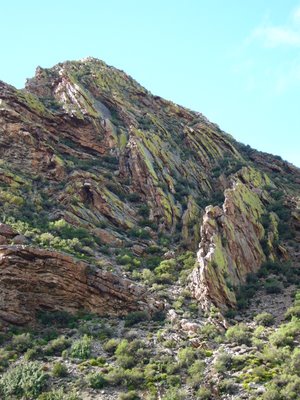Klein Karoo
Our next expedition was inland into an area know as the Klein Karoo (Little Karoo). Our first stop was in Oudtshoorn (pronounced Oats-Sworn) I've covered Geography so now here's a history lesson...First Ostrich Boom
The main reason for the large rise in prosperity was the ostrich, whose feathers had become extremely popular as fashion accessories in Europe; they were especially popular for use on hats. Between 1875 and 1880 ostrich prices reached up to £1,000 a pair. The farmers of the region, realising that ostriches were far more profitable than any other activity, ripped out their other crops and planted lucerne, which was used as feed for the ostriches. The rising wealth also finally allowed for the completion of the Dutch Reformed Church - it was opened on 7th July 1879.
Owing to overproduction, the ostrich industry experienced a sudden slump in fortunes in 1885; the town's misery was compounded when it was hit by severe flooding during the same year, which washed away the nearby Victoria Bridge which had been built over the Olifants River only the year before.
The ostrich industry recovered only slowly and it was not until after the Second Anglo-Boer War of 1899 to 1902 that a second and bigger boom started. It was during this period that most of Oudtshoorn's famously opulent "Feather Palaces" were built. This boom peaked in 1913, before collapsing in 1914. As a result the region's economy was ruined and most farmers returned to more traditional crops. (Wikipedia)

Although Alessandra and I only had coffee in Uodtshoorn I still got a sense of it's history whilst we sat in the church yard of a wonderful old Presbyterian chapel close to the centre of town (Photo Above). We would have likes to have stayed a little longer and explore the town properly but unfortunately time was against us. As we headed out towards Prince Albert we passed countless Ostrich farms, which sat uneasily alongside the wilderness that surrounded them. The rock formations of the Little Karoo were stunning, you could see the strata's of sandstone and granite clearly as well as the different rates of erosion that creates such an aesthetic polarization between the two. Lichen only grows on the granite and gives the rocks an incredibly reflective surface in direct sunlight (photo below).

We wound out way through a large gorge, similar to the dolomites in Italy before emerging into a completely contrasting environment from whence we had left. Prince Albert lies in a valley that for the most part of the last decade has experience drought. I was cursing the weather and my stupidity for wearing too few layers when really i should have been focusing on the incredible act of nature we were witnessing, the first rain in the area for 9yrs. What i would describe as miserable weather has people singing rejoicing in Prince Albert, there couldn't have been a better remedy to my grey mood. Prince Albert seems to incubate and inspire a relatively large arts community for a town of it's size. I became really engaged in a conversation with a local ceramist and enjoyed the paintings of one particular artist so much i slyly took a photo of his work. We also ate lunch at the gallery where there was a very charming lady would kept us entertained with her colourful history. Due to the rain we didn't really venture out too far other than to stroll the central street and appreciate the gables of the old dutch houses (photo below).

Having traveled so far to reach Prince Albert it seems quite perculiar to spend all our time in one building, but in hindsight it really drives home the relaxed nature of the Little Karoo. No ones in a hurry and the pace of life barely has a pulse. As strangers we subconsciously adapted to this way of life in an instant. Had the weather been better i think we would have explored more of Prince Albert, which has left me thinking it's a job unfinished and that'd i'd love come back before I leave South Africa.

0 Comments:
Post a Comment
<< Home